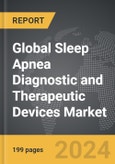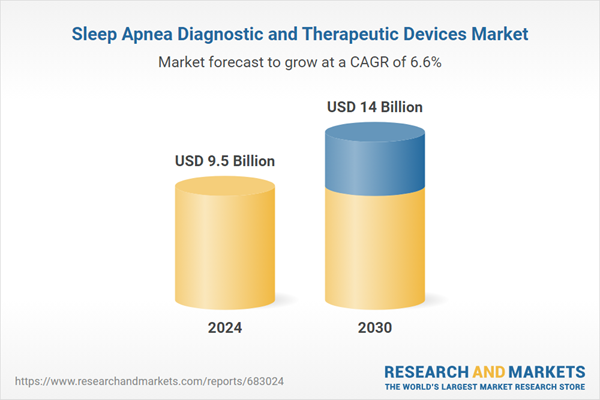The global market for Sleep Apnea Diagnostic and Therapeutic Devices was valued at US$9.5 Billion in 2024 and is projected to reach US$14.0 Billion by 2030, growing at a CAGR of 6.6% from 2024 to 2030. This comprehensive report provides an in-depth analysis of market trends, drivers, and forecasts, helping you make informed business decisions. The report includes the most recent global tariff developments and how they impact the Sleep Apnea Diagnostic and Therapeutic Devices market.
Technological advancements in diagnostic and therapeutic devices have significantly contributed to the market's growth. Modern CPAP machines are becoming smaller, quieter, and more comfortable, enhancing patient compliance. They are often equipped with advanced features such as automatic pressure adjustments, heated humidifiers, and smart connectivity to monitor and improve therapy adherence. Similarly, diagnostic devices, including home sleep test kits, now incorporate wireless connectivity and data analysis features that provide real-time monitoring and accurate diagnoses. These innovations not only improve patient experience but also help clinicians deliver more personalized and effective treatment.
An emerging trend within the market is the rise of alternative therapies and non-invasive devices, expanding the range of treatment options for patients who may be intolerant to traditional CPAP therapy. Oral appliances and positional therapy devices are gaining popularity as they provide a less cumbersome and more comfortable option for certain patients. Additionally, the use of telemedicine and digital health platforms is transforming sleep apnea care, allowing for remote diagnosis, therapy adjustments, and ongoing monitoring. Wearable sensors integrated with sleep apnea devices allow for real-time monitoring of breathing patterns, heart rate, and sleep stages, giving healthcare providers a wealth of comprehensive data to refine treatment. Personalized CPAP machines are also gaining traction, adapting to individual patient needs by automatically adjusting airflow pressure for optimum comfort and efficacy. These innovations are expected to significantly improve patient adherence and treatment outcomes. The integration of digital health technologies into sleep apnea management is expected to continue shaping the future landscape, providing new avenues for patient engagement and optimizing treatment outcomes.
Segments: Type (Diagnostic Devices, Therapeutic Devices); End-Use (Sleep Laboratories & Hospitals, Home Care Settings / Individuals).
Geographic Regions/Countries: World; United States; Canada; Japan; China; Europe (France; Germany; Italy; United Kingdom; Spain; Russia; and Rest of Europe); Asia-Pacific (Australia; India; South Korea; and Rest of Asia-Pacific); Latin America (Argentina; Brazil; Mexico; and Rest of Latin America); Middle East (Iran; Israel; Saudi Arabia; United Arab Emirates; and Rest of Middle East); and Africa.
The analysts continuously track trade developments worldwide, drawing insights from leading global economists and over 200 industry and policy institutions, including think tanks, trade organizations, and national economic advisory bodies. This intelligence is integrated into forecasting models to provide timely, data-driven analysis of emerging risks and opportunities.
Global Sleep Apnea Diagnostic and Therapeutic Device Market - Key Trends and Drivers Summarized
The market for sleep apnea diagnostic and therapeutic devices is primarily driven by the increasing awareness and prevalence of sleep apnea worldwide. As the global population ages and obesity rates rise, the incidence of obstructive sleep apnea (OSA) continues to grow, compelling healthcare providers to prioritize early detection and effective treatment. Governments and healthcare organizations are also raising awareness, emphasizing the health risks associated with untreated sleep apnea, such as cardiovascular diseases and diabetes. This has led to a surge in demand for home sleep testing devices and continuous positive airway pressure (CPAP) therapy, which are more accessible and convenient for patients than traditional in-lab sleep studies.Technological advancements in diagnostic and therapeutic devices have significantly contributed to the market's growth. Modern CPAP machines are becoming smaller, quieter, and more comfortable, enhancing patient compliance. They are often equipped with advanced features such as automatic pressure adjustments, heated humidifiers, and smart connectivity to monitor and improve therapy adherence. Similarly, diagnostic devices, including home sleep test kits, now incorporate wireless connectivity and data analysis features that provide real-time monitoring and accurate diagnoses. These innovations not only improve patient experience but also help clinicians deliver more personalized and effective treatment.
An emerging trend within the market is the rise of alternative therapies and non-invasive devices, expanding the range of treatment options for patients who may be intolerant to traditional CPAP therapy. Oral appliances and positional therapy devices are gaining popularity as they provide a less cumbersome and more comfortable option for certain patients. Additionally, the use of telemedicine and digital health platforms is transforming sleep apnea care, allowing for remote diagnosis, therapy adjustments, and ongoing monitoring. Wearable sensors integrated with sleep apnea devices allow for real-time monitoring of breathing patterns, heart rate, and sleep stages, giving healthcare providers a wealth of comprehensive data to refine treatment. Personalized CPAP machines are also gaining traction, adapting to individual patient needs by automatically adjusting airflow pressure for optimum comfort and efficacy. These innovations are expected to significantly improve patient adherence and treatment outcomes. The integration of digital health technologies into sleep apnea management is expected to continue shaping the future landscape, providing new avenues for patient engagement and optimizing treatment outcomes.
Report Scope
The report analyzes the Sleep Apnea Diagnostic and Therapeutic Devices market, presented in terms of units. The analysis covers the key segments and geographic regions outlined below.Segments: Type (Diagnostic Devices, Therapeutic Devices); End-Use (Sleep Laboratories & Hospitals, Home Care Settings / Individuals).
Geographic Regions/Countries: World; United States; Canada; Japan; China; Europe (France; Germany; Italy; United Kingdom; Spain; Russia; and Rest of Europe); Asia-Pacific (Australia; India; South Korea; and Rest of Asia-Pacific); Latin America (Argentina; Brazil; Mexico; and Rest of Latin America); Middle East (Iran; Israel; Saudi Arabia; United Arab Emirates; and Rest of Middle East); and Africa.
Key Insights:
- Market Growth: Understand the significant growth trajectory of the Diagnostic Devices segment, which is expected to reach US$7.1 Billion by 2030 with a CAGR of a 6.3%. The Therapeutic Devices segment is also set to grow at 6.9% CAGR over the analysis period.
- Regional Analysis: Gain insights into the U.S. market, valued at $2.5 Billion in 2024, and China, forecasted to grow at an impressive 9.8% CAGR to reach $3.2 Billion by 2030. Discover growth trends in other key regions, including Japan, Canada, Germany, and the Asia-Pacific.
Why You Should Buy This Report:
- Detailed Market Analysis: Access a thorough analysis of the Global Sleep Apnea Diagnostic and Therapeutic Devices Market, covering all major geographic regions and market segments.
- Competitive Insights: Get an overview of the competitive landscape, including the market presence of major players across different geographies.
- Future Trends and Drivers: Understand the key trends and drivers shaping the future of the Global Sleep Apnea Diagnostic and Therapeutic Devices Market.
- Actionable Insights: Benefit from actionable insights that can help you identify new revenue opportunities and make strategic business decisions.
Key Questions Answered:
- How is the Global Sleep Apnea Diagnostic and Therapeutic Devices Market expected to evolve by 2030?
- What are the main drivers and restraints affecting the market?
- Which market segments will grow the most over the forecast period?
- How will market shares for different regions and segments change by 2030?
- Who are the leading players in the market, and what are their prospects?
Report Features:
- Comprehensive Market Data: Independent analysis of annual sales and market forecasts in US$ Million from 2024 to 2030.
- In-Depth Regional Analysis: Detailed insights into key markets, including the U.S., China, Japan, Canada, Europe, Asia-Pacific, Latin America, Middle East, and Africa.
- Company Profiles: Coverage of players such as Cadwell Laboratories Inc., Cleveland Medical Devices Inc., Compumedics Ltd., DeVilbiss Healthcare, Fisher & Paykel Healthcare Ltd. and more.
- Complimentary Updates: Receive free report updates for one year to keep you informed of the latest market developments.
Some of the 54 companies featured in this Sleep Apnea Diagnostic and Therapeutic Devices market report include:
- Cadwell Laboratories Inc.
- Cleveland Medical Devices Inc.
- Compumedics Ltd.
- DeVilbiss Healthcare
- Fisher & Paykel Healthcare Ltd.
- Itamar Medical Ltd.
- Löwenstein Medical Technology GmbH + Co. KG
- Natus Medical Inc.
- Philips Healthcare
- ResMed Inc.
- Teleflex Inc.
- Vyaire Medical Inc.
Tariff Impact Analysis: Key Insights for 2025
Global tariff negotiations across 180+ countries are reshaping supply chains, costs, and competitiveness. This report reflects the latest developments as of April 2025 and incorporates forward-looking insights into the market outlook.The analysts continuously track trade developments worldwide, drawing insights from leading global economists and over 200 industry and policy institutions, including think tanks, trade organizations, and national economic advisory bodies. This intelligence is integrated into forecasting models to provide timely, data-driven analysis of emerging risks and opportunities.
What’s Included in This Edition:
- Tariff-adjusted market forecasts by region and segment
- Analysis of cost and supply chain implications by sourcing and trade exposure
- Strategic insights into geographic shifts
Buyers receive a free July 2025 update with:
- Finalized tariff impacts and new trade agreement effects
- Updated projections reflecting global sourcing and cost shifts
- Expanded country-specific coverage across the industry
Table of Contents
I. METHODOLOGYII. EXECUTIVE SUMMARY2. FOCUS ON SELECT PLAYERSIII. MARKET ANALYSISSOUTH KOREAREST OF ASIA-PACIFICARGENTINABRAZILMEXICOREST OF LATIN AMERICAIRANISRAELSAUDI ARABIAUNITED ARAB EMIRATESREST OF MIDDLE EASTIV. COMPETITION
1. MARKET OVERVIEW
3. MARKET TRENDS & DRIVERS
4. GLOBAL MARKET PERSPECTIVE
UNITED STATES
CANADA
JAPAN
CHINA
EUROPE
FRANCE
GERMANY
ITALY
UNITED KINGDOM
SPAIN
RUSSIA
REST OF EUROPE
ASIA-PACIFIC
AUSTRALIA
INDIA
LATIN AMERICA
MIDDLE EAST
AFRICA
Companies Mentioned (Partial List)
A selection of companies mentioned in this report includes, but is not limited to:
- Cadwell Laboratories Inc.
- Cleveland Medical Devices Inc.
- Compumedics Ltd.
- DeVilbiss Healthcare
- Fisher & Paykel Healthcare Ltd.
- Itamar Medical Ltd.
- Löwenstein Medical Technology GmbH + Co. KG
- Natus Medical Inc.
- Philips Healthcare
- ResMed Inc.
- Teleflex Inc.
- Vyaire Medical Inc.
Table Information
| Report Attribute | Details |
|---|---|
| No. of Pages | 199 |
| Published | April 2025 |
| Forecast Period | 2024 - 2030 |
| Estimated Market Value ( USD | $ 9.5 Billion |
| Forecasted Market Value ( USD | $ 14 Billion |
| Compound Annual Growth Rate | 6.6% |
| Regions Covered | Global |









